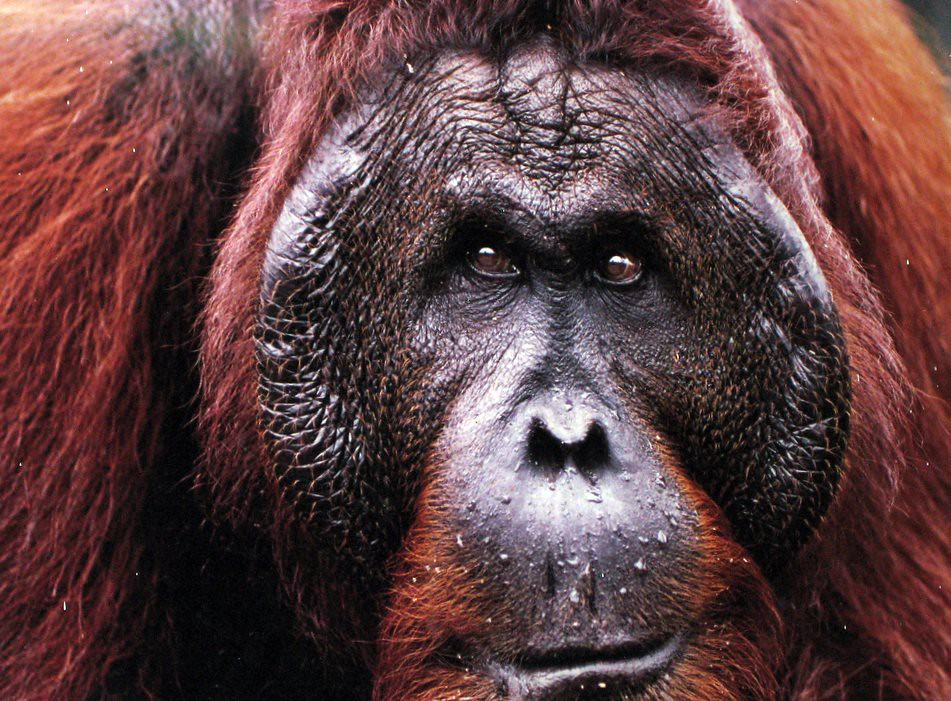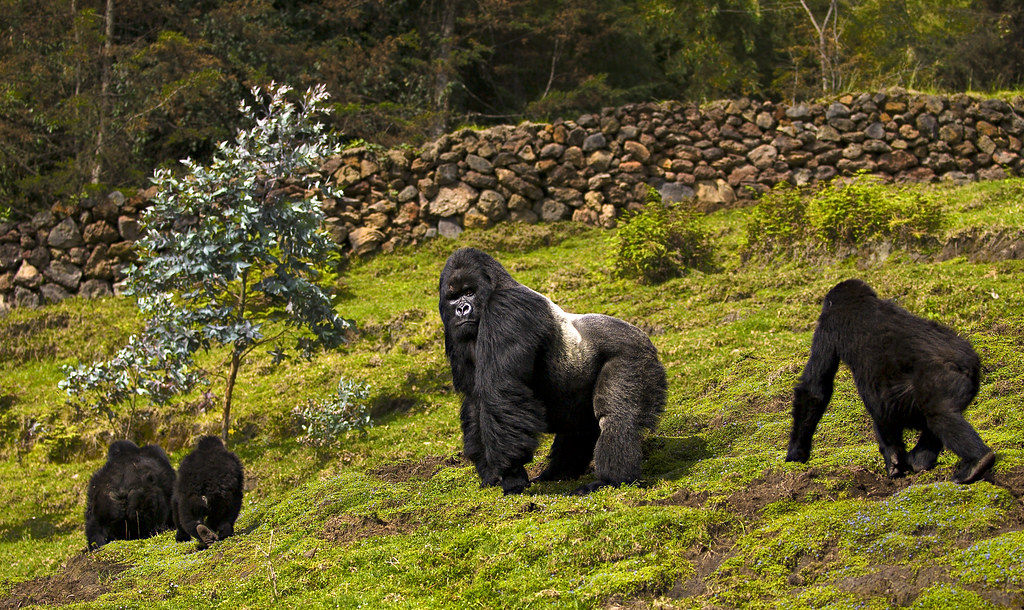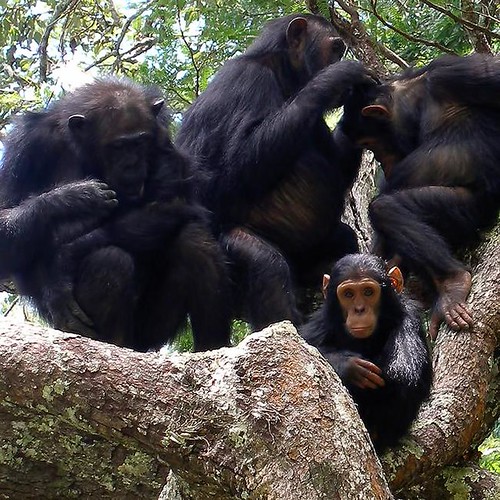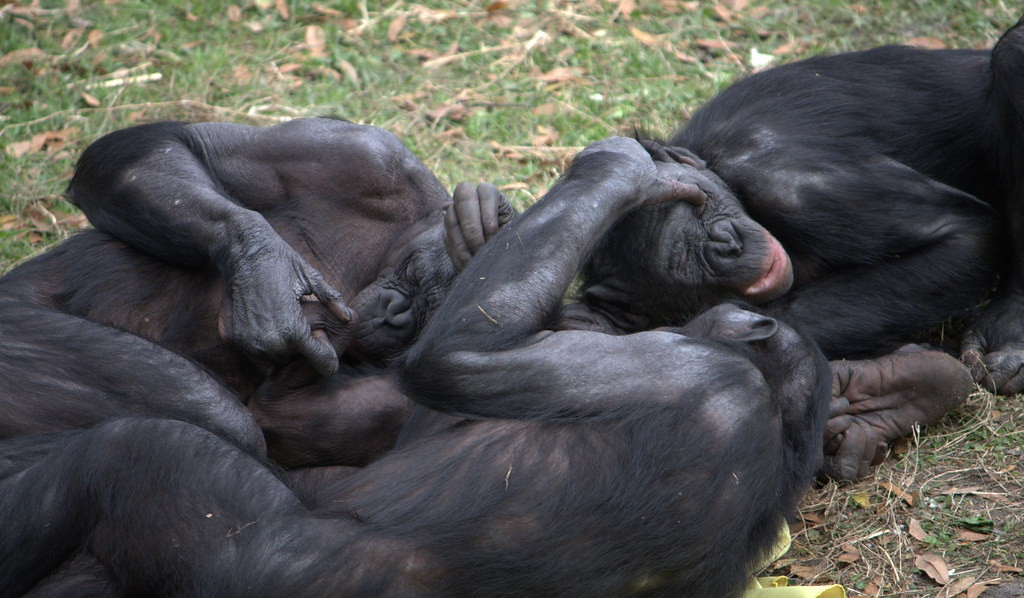4.4 Great Ape Social Systems
Primate sociality, in particular the great apes, is incredibly important to the success of the primate order. There are many costs and benefits to living as social animals. On one hand, there is safety and survival in numbers including reduced predation on individuals in the group and the potential for shared care of offspring. However, there are also costs. Competition for mates, aggression over food in times of low resources, and ostracism for not following the rules can leave the best of apes in a tight spot.
The various social systems among primates are often driving by these trade-offs. How competitive are the males? How plentiful are resources like food and water? Do females (and sometimes males) share in offspring care? These and other factors can result in distinct differences in social interactions, organization, and stability.
Orangutans
Orangutans live in a social system known as solitary single male, multifemale. A fully flanged male (one with the large cheek pads so commonly associated with orangutans) will oversee a large, solitary territory. Within that territory, equally solitary females will keep their own, separate ranges in which they forage and raise their young. As a result, the fully flanged male will visit the females as he roams, primarily for protection and mating. Unfortunately, this uneven ratio of sexes often results in forced copulations from younger males who do not have territory.
In the event that a young male attempts forced copulation, females often scream loudly, notifying the fully flanged male that they are in danger. When the fully flanged male arrives, he may be lucky enough to simply scare off the younger male. However, depending upon how confident the young male feels, he may choose to challenge the elder male in a fight. If the young interlocuter wins, the elder male will leave the territory. Subsequently, the younger male experiences a spike in testosterone and grows cheek pads, becoming the new, fully flanged male of the group.

Gorillas
Gorillas also live in single male, multifemale groups. However, in the case of gorillas, the male stays with the females in his range. The silverback, or dominant male, is often subdued and caring of the females and offspring. While the females do not immediately care for each other’s offspring, foraging and nursing can often be social events. Silverback gorillas can be two to three times the size of the average female.
Gorillas are also known for bachelor herds. These males are slightly smaller than a silverback and may exhibit tufts of silver on a black back or develop a full silver coat. They often roam together, foraging and socializing. Additionally, male-male sexual contact is not uncommon in these groups.
Occasionally, a member of the bachelor herd will attempt to attract a female in the care of a silverback. This may be done inconspicuously, so as not to garner the silverback’s attention. If the female agrees, the two will separate into their own group. However, if the female does not see the new suitor as, well, suitable, the male may find himself in conflict with the silverback. In most cases, the silverback’s size and the support of the females in his group result in a clear win for the silverback. But! Sometimes, the younger male’s strength and youth overpower the silverback. In these cases, the females may find their youngest offspring in danger as the new silverback seeks to establish the group as his.

Chimpanzees
Chimpanzees live in multi-male, multi-female social groups. These groups will range a designated territory, and there is often a strict social hierarchy among each sex. The male hierarchy is quite strict and often designates who has prime access to resources – including mating opportunities with females. Because of this, males are highly competitive and may even be manipulative of others. In many of his book, including Chimpanzee Politics, Frans de Waal documents occasions of two lower ranking males working together to overthrow an existing dominant male.
The female hierarchy is based more upon age and status among the males. For example, Mama (another chimpanzee whose legacy is frequently shared by de Waal), was the oldest female in a group of captive chimpanzees in the Netherlands. She was known for her ability to break up fights between males, and even the alpha male would commonly concede to her interruptions. She was also capable of prompting reconciliations between fighting males. In cases when other females were either fighting or being harassed by a male, Mama was among the few who could stave off further conflict.
In chimpanzee groups, few males below the top ranking two or three males will have the opportunity to mate without fear. Other males may attempt to consort with females, leading them away from the rest of the group into a private corner of the territory. However, unless the male in question has the favor of the alpha, this can be a dangerous, even life-threatening activity.
Chimpanzees are incredibly territorial. Numerous stories tell of intergroup fighting that leads to the death of one or more chimpanzees. These territorial disputes may be the result of roaming, but often occur when a party of chimpanzees hunting colobus monkey find themselves led astray by their prey.

Bonobos
Like chimpanzees, bonobos also live in multi-male, multi-female groups. However, rather than having a strict hierarchy in each sex, bonobo groups are loosely steered by the females. Known as the hippies of the ape world, bonobos tend to solve nearly every dispute with some form of sexual contact. Likewise, trades of intimate touch may be given in exchange for food or access to other resources. In fact, when two unrelated troops of bonobos meet on a territorial boundary, they are significantly more likely to share food and sexual contact than to fight. This is in stark contrast to chimpanzees.
Aside from humans, bonobos are the only apes to kiss as a sign of affection. They are also the only other ape to engage in face-to-face intercourse. Mixed groups (by age or sex) may congregate to cuddle and groom each other. Food sharing is much more common, and research suggests that bonobos are more cooperative and tolerant of each other’s presence compared with chimpanzees.
Since our evolutionary history branched from chimpanzees and bonobos before the two became distinct species, scientists often debate to which we may be more similar. In truth, we are like either, yet completely distinct from both. We can certainly be warring and territorial, with strong male hierarchies that lead our societies. Yet, we can also be incredibly caring, even to strangers, and heed the strength and wisdom of our females.

the tendency to associate in or form social groups; being social or navigating a social group.
a social group in which females have individual territories encompassed by a single male whose territory includes all of the female's territories.
a social group in which an alpha male and his female mates live in the same territory. Other adult males are usually not tolerated by the alpha male.
a group of (usually) juvenile male animals who are still sexually immature or who have been thrown out of their parent groups but not yet formed a new family group.
a social group in which males and females share territory; may be male led (patriarchal) or female led (matriarchal).
controlling, prevailing, or powerful position especially in a social hierarchy; may be taken or given depending upon the nature of the group.

